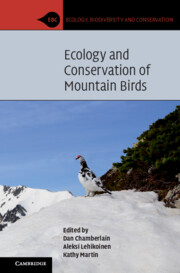Book contents
- Ecology and Conservation of Mountain Birds
- Ecology, Biodiversity and Conservation
- Ecology and Conservation of Mountain Birds
- Copyright page
- Contents
- Contributors
- Preface
- Acknowledgements
- 1 Mountain Birds and Their Habitats
- 2 Avian Adaptations to High Mountain Habitats
- 3 Global Bird Communities of Alpine and Nival Habitats
- 4 Birds of Treeline Ecotones
- 5 Population Trends of Mountain Birds in Europe and North America
- 6 Climate Change Impacts on Mountain Birds
- 7 Anthropogenic Activities and Mountain Birds
- 8 Modelling Large-Scale Patterns in Mountain Bird Diversity and Distributions
- 9 The Alpine Avifauna of Tropical Mountains
- 10 Priorities for Information, Research and Conservation of Birds in High Mountains
- Bird Species Index
- Subject Index
- Plate Section (PDF Only)
- References
5 - Population Trends of Mountain Birds in Europe and North America
Published online by Cambridge University Press: 30 June 2023
- Ecology and Conservation of Mountain Birds
- Ecology, Biodiversity and Conservation
- Ecology and Conservation of Mountain Birds
- Copyright page
- Contents
- Contributors
- Preface
- Acknowledgements
- 1 Mountain Birds and Their Habitats
- 2 Avian Adaptations to High Mountain Habitats
- 3 Global Bird Communities of Alpine and Nival Habitats
- 4 Birds of Treeline Ecotones
- 5 Population Trends of Mountain Birds in Europe and North America
- 6 Climate Change Impacts on Mountain Birds
- 7 Anthropogenic Activities and Mountain Birds
- 8 Modelling Large-Scale Patterns in Mountain Bird Diversity and Distributions
- 9 The Alpine Avifauna of Tropical Mountains
- 10 Priorities for Information, Research and Conservation of Birds in High Mountains
- Bird Species Index
- Subject Index
- Plate Section (PDF Only)
- References
Summary
This chapter summaries what is known about population trends of mountain birds, especially in Europe and North America. A European mountain bird indicator, which summaries the population trends of 44 alpine species, suggests an overall slightly increasing mountain bird population during 2002–2020. Regional North American indicators, based on up to seven alpine species showed either stable or declining trends during 1968–2020. In European mountains, cold-dwelling species had on average less favourable regional population trends than warm-dwelling species, and long-distance migrants tended to have more negative trends than short-distance migrants and residents. There were also spatial differences in trends of the indicators in Europe: mountain birds in general increased in the Alps but decreased in the UK. A comparison between two European breeding bird atlases showed that the distribution area of mountain birds has generally decreased since the 1980s, and mountain specialists have lost more of their range than mountain generalists. Monitoring alpine species presents many challenges which has led to poor coverage in surveys even in areas with well organised bird monitoring programmes at low elevation. The necessary future improvements needed for successful bird population monitoring in mountain areas will, in many instances, require strong financial support.
Keywords
- Type
- Chapter
- Information
- Ecology and Conservation of Mountain Birds , pp. 176 - 214Publisher: Cambridge University PressPrint publication year: 2023



